Call Model and Test-Verification Methods for PS-LTE Core Equipment
Abstract
:1. Introduction
2. Call Model and Test Result for Core Equipment
2.1. Core Equipment Test Environment
2.2. MCPTT Core System Test Model
- MCPTT voice outgoing call of 320,000 BHCA, incoming call of 320,000 BHCA, and 40,000 simultaneous-access call approvals (average holding time = 225 s);
- MCPTT video outgoing call of 3.2 million BHCA, incoming call of 3.2 million BHCA, and 40,000 simultaneous call approvals (average holding time = 225 s);
- MCPTT MSG of 200,000 BHCA and incoming of 200,000 BHCA call approvals;
- MCPTT linkage of 240,000 BHRA INIT-REG and 240,000 BHRA DE-REG approval.
2.3. MME Core System Test Model
2.4. SAE-GW Core System Test Model
2.5. Discussion
3. Field Test Scenarios for MCPTT and eMBMS
3.1. MCPTT Field-Test Scenarios
- Step 1 (channel information inquiry): after an originating terminal performs the authentication procedure for a subscriber, it sends an inquiry to the CSC about the channel information under the subscriber’s management.
- Step 2 (voice channel creation request): a request is made for the creation of a channel by transmitting a SIP:INVITE message containing the channel ID to the CSCF.
- Step 3 (voice channel creation request): the CSCF forwards the message to the PTT server.
- Step 4 (channel member inquiry): the MCPTT server acquires the member list of the corresponding channel from the CSC server.
- Step 5 (voice channel participation request): the MCPTT server requests channel participation to the channel members by transmitting a SIP:INVITE message.
- KPI 1 restricts the required time to acquire permission to talk to within 300 ms.
- KPI 2 restricts the end-to-end call connection time (invite to 200 OK) to within 1000 ms.
- KPI 3 restricts the end-to-end media transmission delay time (mouth-to-ear latency) to within 300 ms when encryption is not applied.
3.2. eMBMS Field Test Scenarios
3.3. Discussion
4. Measurement of Wireless Coverage and Quality
4.1. Measurement of Coverage and Call Quality
4.2. Measurement of End-to-End Call Services
- For interception, only voice and data are measured, excluding voice transmission delay, voice quality, and data call connection measurement, while command devices and measuring instruments are not connected.
- For individual calls, voice/data call connection time, call time, voice quality, data transmission time, and video quality are measured.
- For group calls, voice/data call connection time, call time, voice transmission delay, voice quality, and data transmission time are measured, and the quality of group video is evaluated using the recorded video in the terminals.
- For multiple call group receptions, call connection time and call time are measured, excluding delivery delay time and voice quality, because measuring instruments cannot confirm whether the terminal has succeeded in moving from call group A to B.
- For multiuser full-duplex calls, call connection time and call time are measured, excluding voice quality, because measuring instruments cannot measure voice quality received in a mixed state of voices transmitted from several different terminals.
- The success rate of text transmission is measured at 100%, and also measured are the completion rate of individual calls (voice—97%; video—97%), and the completion rate of group calls (voice—96%; video—99%).
- Because the communication environment between a tunnel section (commercial networks) and a ground section (disaster networks) changes frequently, the policy of RAN sharing with commercial networks should be clearly defined.
- As the radio resource control (RRC) connection release time is different for each business area, consultation among business operators is required; if no traffic is present in area A for 10 s, it transitions to the RRC_IDLE state due to the occurrence of RRC connection release.
- Strengthening the examination of areas where DSCN services are weak is necessary, including the boundary area between disaster and commercial networks in mountainous areas, the boundary area between business operators, and the boundary area between regions (numerous call drops and network connection failures occur due to RAN-sharing failures).
4.3. Testing Mobile Base Stations
4.3.1. Coverage Test Results of Vehicle-Type Mobile Base Stations
4.3.2. Test Results of the Network Performance of Vehicle-Type Mobile Base Stations
4.4. Summary and Analysis of Test Results
- The target of service area for disaster safety communication network is densely populated areas including national infrastructure and roads with two or more lanes. However, as a result of the coverage test, there are many areas share with commercial network due to the shaded sections; hence, it is necessary to improve and optimize the coverage.
- As the area where the disaster safety communication network and LTE-R RAN Sharing are not applied is measured, the voice call quality of the disaster safety communication network service is very poor. Therefore, early interworking measures through consultation with involved organizations are required.
- When measuring disaster safety communication network and LTE-M RAN-sharing, because there are many cases where the Physical Resource Block is not allocated and data cannot be transmitted at the transmission rate (DL, UL) 0 Mbps, it is necessary to check the RAN-sharing parameter and the system.
- Due to the coverage shadow section between the disaster safety communication network and LTE-M and the instability of RAN sharing, poor voice call quality, such as call drops and call fails, occurs; hence, optimization work is needed to improve the coverage between public networks.
- The overall voice call quality in the boundary area between different types is good. However, because of poor coverage in some areas and quality deterioration due to the base station, output abnormality occurs; hence, equipment inspection and coverage optimization are required.
4.5. Discussion
5. Conclusions
Author Contributions
Funding
Acknowledgments
Conflicts of Interest
References
- 3GPP. Study on Architecture Enhancements to Support Group Communication System Enablers for LTE (GCSE_LTE). Available online: https://portal.3gpp.org/desktopmodules/Specifications/SpecificationDetails.aspx?specificationId=873 (accessed on 2 August 2012).
- 3GPP. Service Aspects and Requirements for Network Sharing. Available online: https://portal.3gpp.org/desktopmodules/Specifications/SpecificationDetails.aspx?specificationId=705 (accessed on 4 August 2012).
- 3GPP. Mission Critical Push To Talk (MCPTT) over LTE.; Stage 1. Available online: https://portal.3gpp.org/desktopmodules/Specifications/SpecificationDetails.aspx?specificationId=623 (accessed on 4 August 2012).
- 3GPP. Feasibility Study for Proximity Services (ProSe) (Release 12). Available online: https://portal.3gpp.org/desktopmodules/Specifications/SpecificationDetails.aspx?specificationId=653 (accessed on 5 August 2012).
- 3GPP. Evolved Universal Terrestrial Radio Access (E-UTRA) and Evolved Universal Terrestrial Radio Access Network (E-UTRAN); Overall Descriptions; Stage 2. Available online: https://portal.3gpp.org/desktopmodules/Specifications/SpecificationDetails.aspx?specificationId=2430 (accessed on 6 August 2012).
- NPSTC. 700MHz Public Safety Broadband Task Force Report and Recommendations; NPSTC: Ellsworth, ME, USA, 2009. [Google Scholar]
- FCC. Connecting America: The National Broadband Plan; Federal Communications Commission: Washington, DC, USA, 2010. [Google Scholar]
- Ghafoor, S.; Sutton, P.D.; Sreenan, C.J.; Brown, K.N. Cognitive radio for disaster response networks: Survey, potential, and challenges. IEEE Wirel. Commun. 2014, 21, 70–80. [Google Scholar] [CrossRef]
- Casoni, M.; Grazia, C.A.; Klapez, M.; Patriciello, N.; Amditis, A.; Sdongos, E. Integration of satellite and LTE for disaster recovery. IEEE Commun. Mag. 2015, 53, 47–53. [Google Scholar] [CrossRef]
- Kumbhar, A.; Koohifar, F.; Givenc, I.; Mueller, B. A survey on legacy and emerging technologies for public safety communications. IEEE Commun. Surv. Tutor. 2017, 19, 97–124. [Google Scholar] [CrossRef]
- Jarwan, A.; Sabbah, A.; Ibnkahla, M.; Issa, O. LTE-based public safety networks: A survey. IEEE Commun. Surv. Tutor. 2019, 21, 1165–1187. [Google Scholar] [CrossRef]
- Park, N.H.; Lee, S.K.; Lee, K.C.; Kim, D.J.; Kwon, D.S. Technical mode for national safety disaster communication network. Inf. Commun. Mag. 2014, 31, 12–18. [Google Scholar]
- Casoni, M.; Guo, S.; Benslimane, A. Emergency networks and future public safety systems. Wirel. Commun. Mob. Comput. 2019, 2019, 1647092. [Google Scholar] [CrossRef] [Green Version]
- Gebremariam, A.A.; Usman, M.; Bassoli, R.; Granelli, F. SoftPSN: Software-defined resource slicing for low-latency reliable public safety networks. Wirel. Commun. Mob. Comput. 2018, 2018, 7253283. [Google Scholar] [CrossRef] [Green Version]
- Mission Critical Push to Talk (MCPTT) over LTE. Available online: https://www.etsi.org/deliver/etsi_ts/122100_122199/122179/15.02.00_60/ts_122179v150200p.pdf (accessed on 13 August 2012).
- Kaleem, Z.; Chang, K. Public safety priority-based user association for load balancing and interference reduction in PS-LTE systems. IEEE Access 2016, 4, 9775–9785. [Google Scholar] [CrossRef]
- Deng, Z.; Liu, X.; Qu, Z.; Hou, C.; Si, W. Robust heading estimation for indoor pedestrian navigation using unconstrained smartphones. Wireless Communications and Mobile Computing. Wirel. Commun. Mob. Comput. 2018, 2018, 5607036. [Google Scholar] [CrossRef]
- Jo, S.-W.; Jang, J.H.; Yu, S.; Shim, W. A validation of field test results for LTE-maritime. IFAC-PapersOnLine 2018, 51, 153–158. [Google Scholar] [CrossRef]
- Feng, S.; Liu, C.; Shen, C.; Choi, H.-A.; Rouil, R.A. An effective and efficient dynamic embms multicast grouping scheduling algorithm in MBSFNs for public safety scenarios. IEEE Access 2020, 8, 105701–105712. [Google Scholar] [CrossRef] [PubMed]
- Kaliski, R.; Chou, C.-C.; Wei, H.-Y. Further enhanced multimedia broadcast/multicast service in LTE-advanced pro. IEEE Commun. Stand. Mag. 2019, 3, 44–51. [Google Scholar] [CrossRef]
- Chen, W.; Ahmad, I.; Chang, K. Co-channel interference management using eICIC/FeICIC with coordinated scheduling for the coexistence of PS-LTE and LTE-R networks. EURASIP J. Wirel. Commun. Netw. 2017, 2017, 2. [Google Scholar] [CrossRef] [Green Version]
- Duong, T.Q.; Hoang, L.N.; Bao, V.N.Q. On the performance of two-way amplify-and-forward relay networks. IEICE Trans. Commun. 2009, 92, 3957–3959. [Google Scholar] [CrossRef]
- ITU-T Recommendation G.722.2. Wideband Coding of Speech at Around 16kbts/s Using Adaptive Multi-Rate Wide-Band(AMR-WB); ITU-T: Paris, France, 2003.
- ITU-T Recommendation G.107. The E-Model: A Computational Model for Use in Transmission Planning; ITU-T: Paris, France, 2008.
- ITU-T G.107.1. Recommendation Wideband E-Model; ITU-T: Paris, France, 2011.
- Song, B.; Lim, K.; Lee, B.; Cho, D.; Lee, H.; Jang, J.; Chang, K. SMART-Navigation over Pilot LTE-maritime: Deployment and coexistence with PS-LTE. IEEE Commun. Mag. 2019, 57, 126–131. [Google Scholar] [CrossRef]
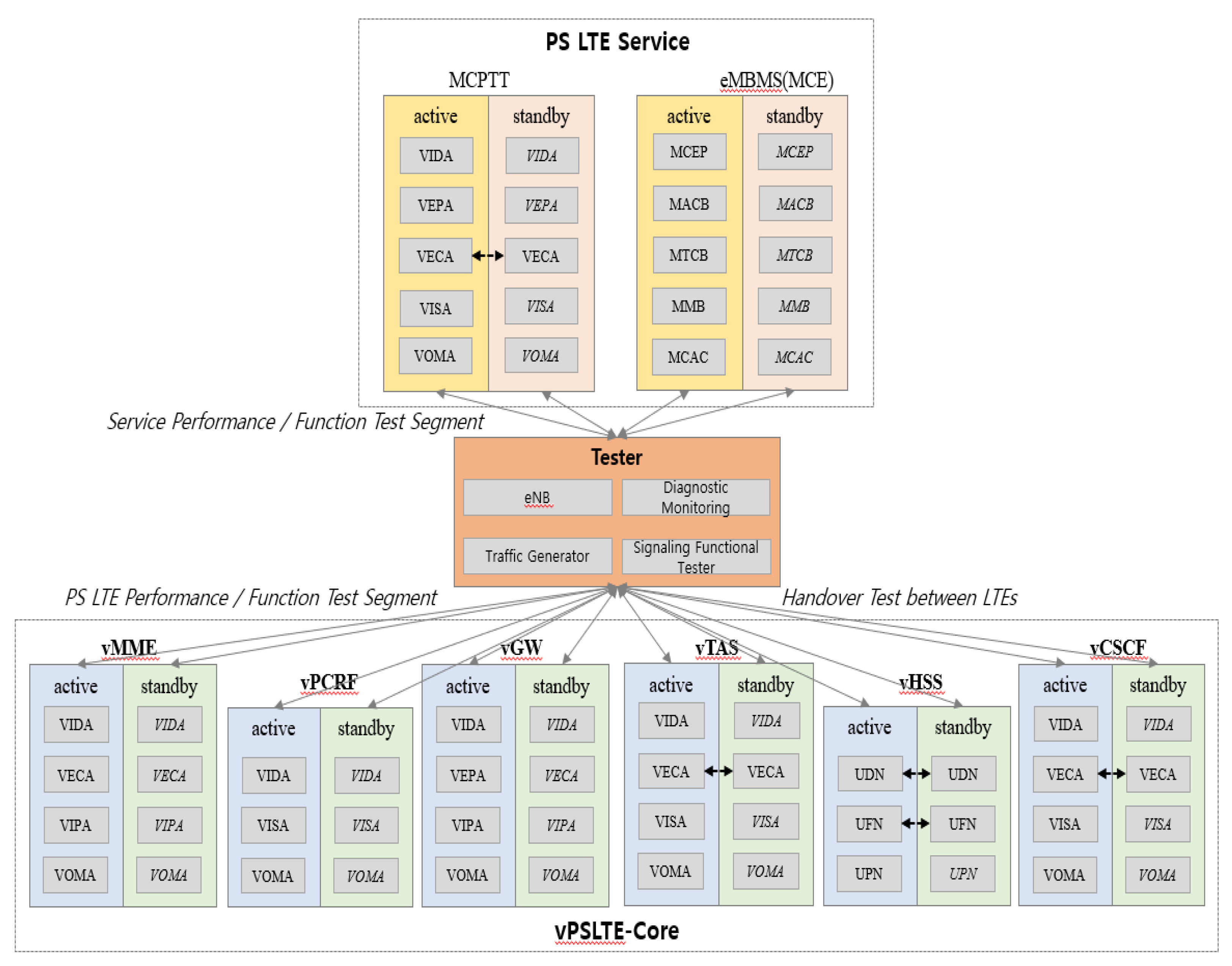



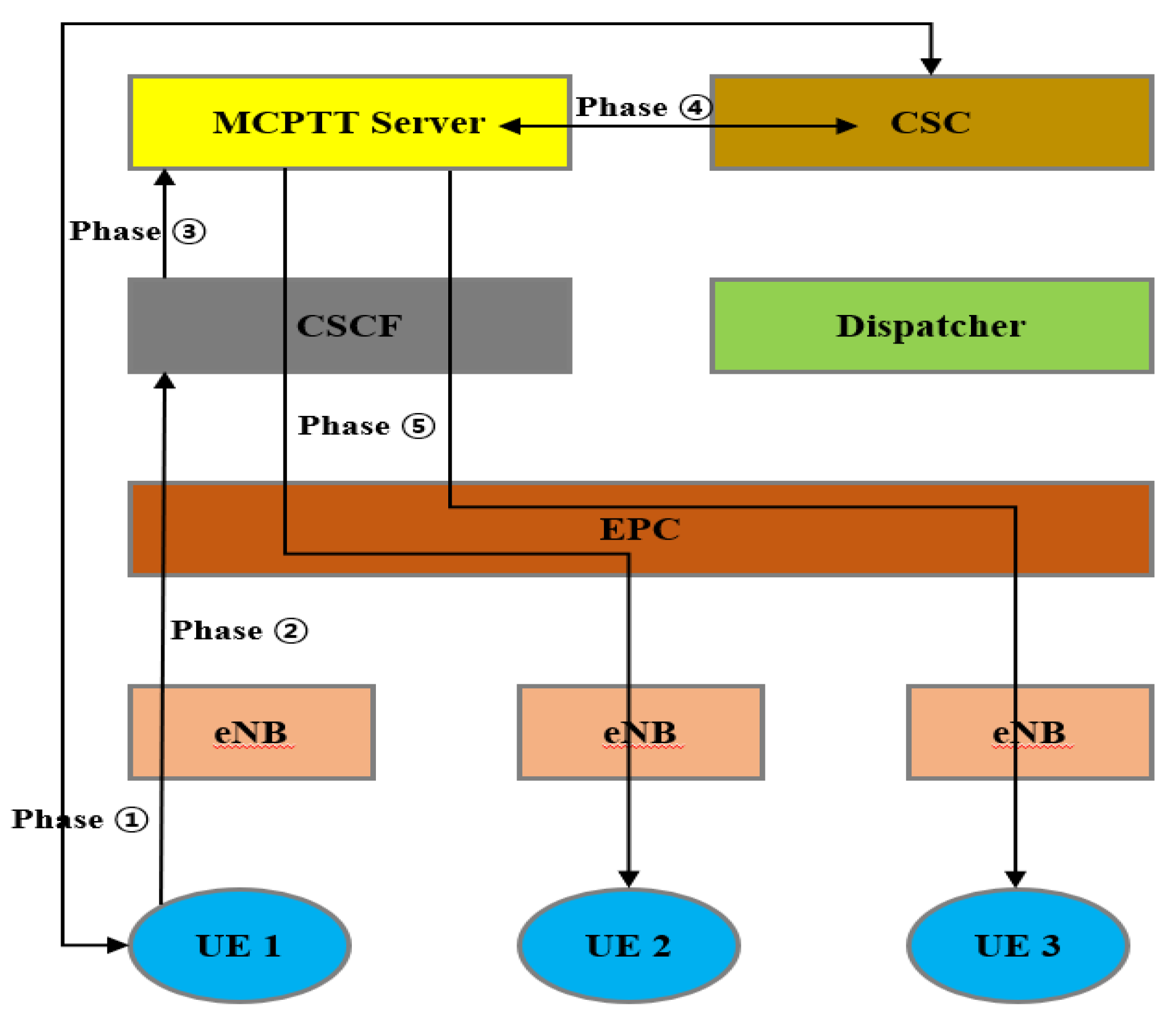
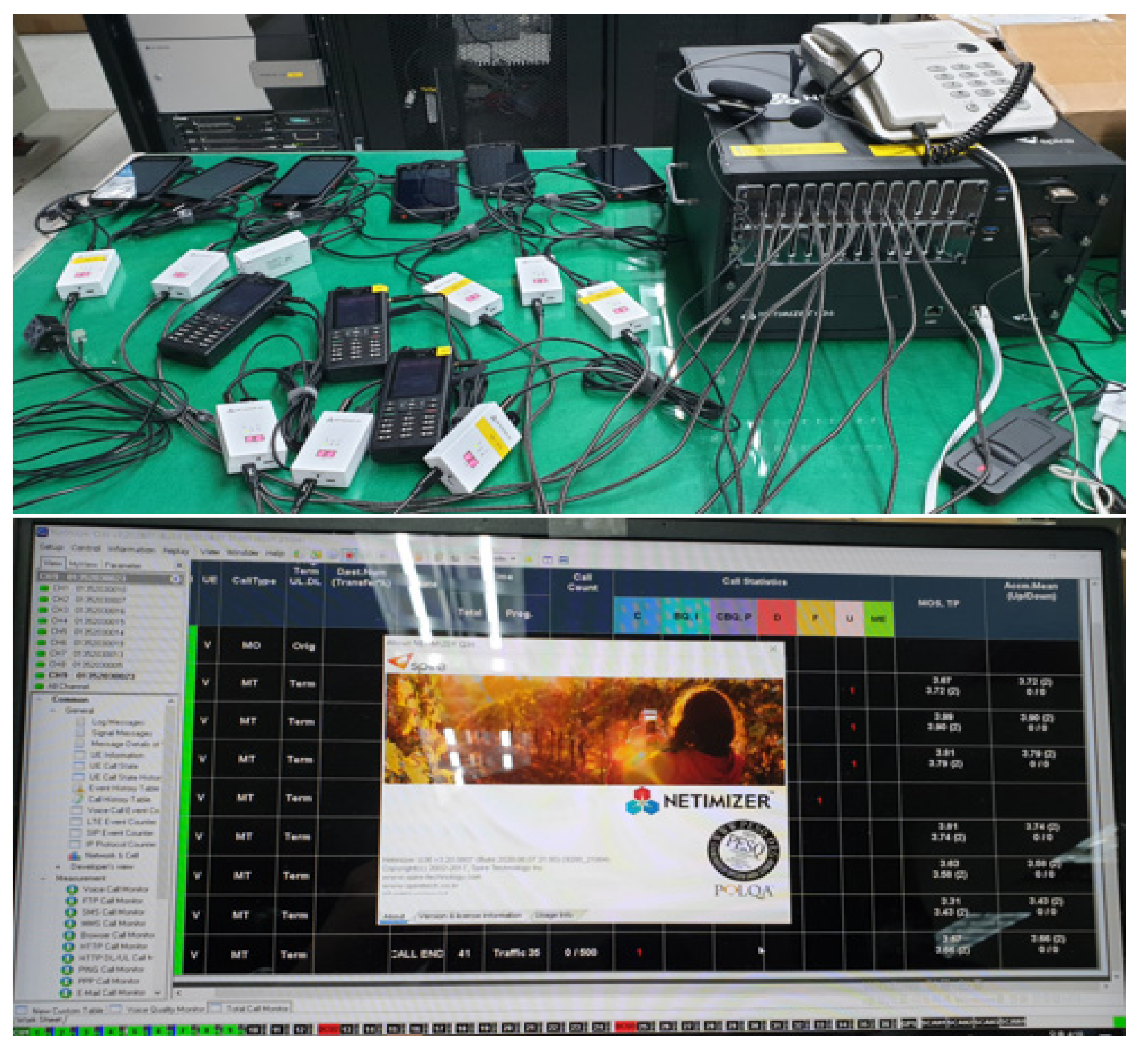
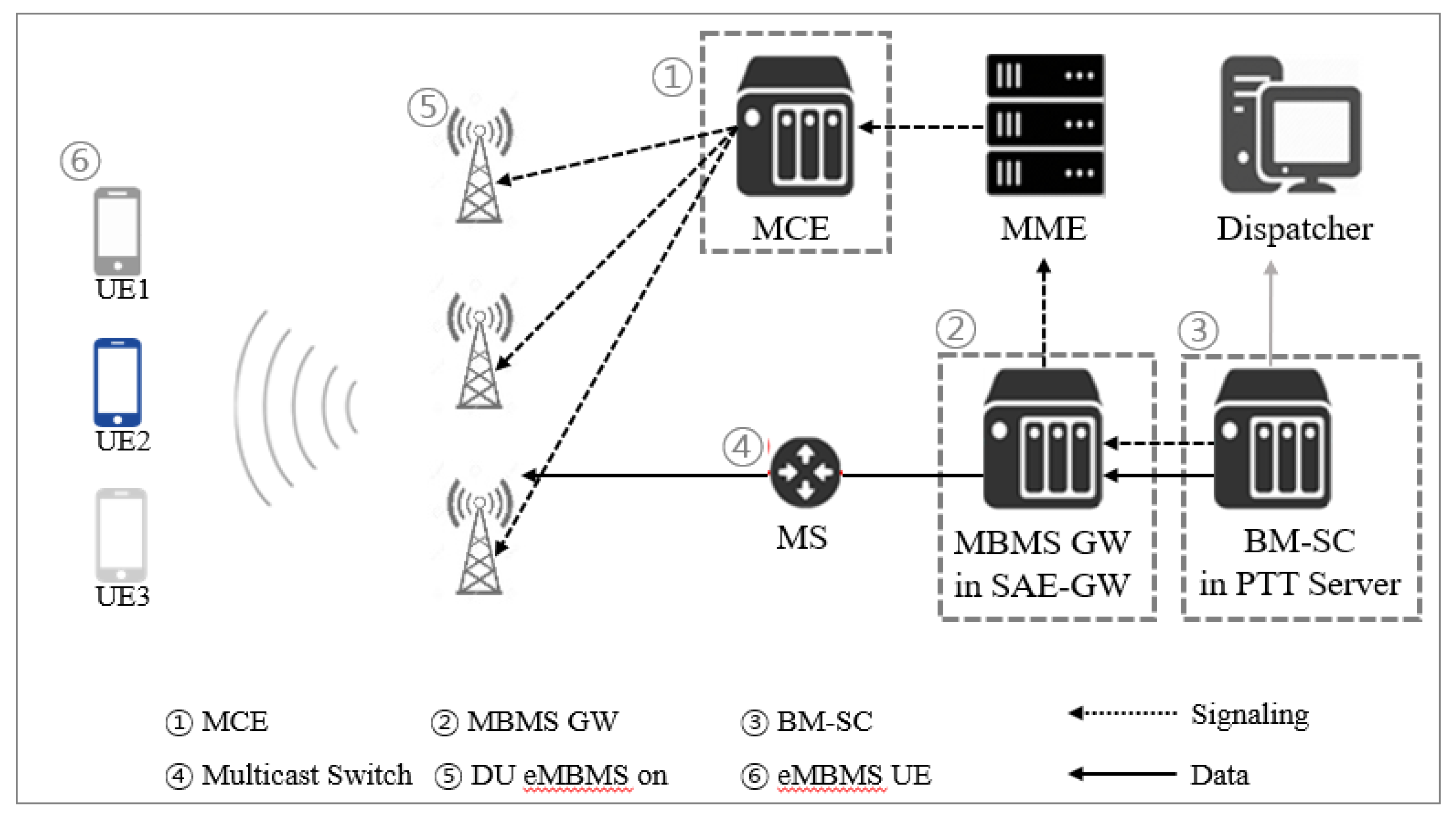

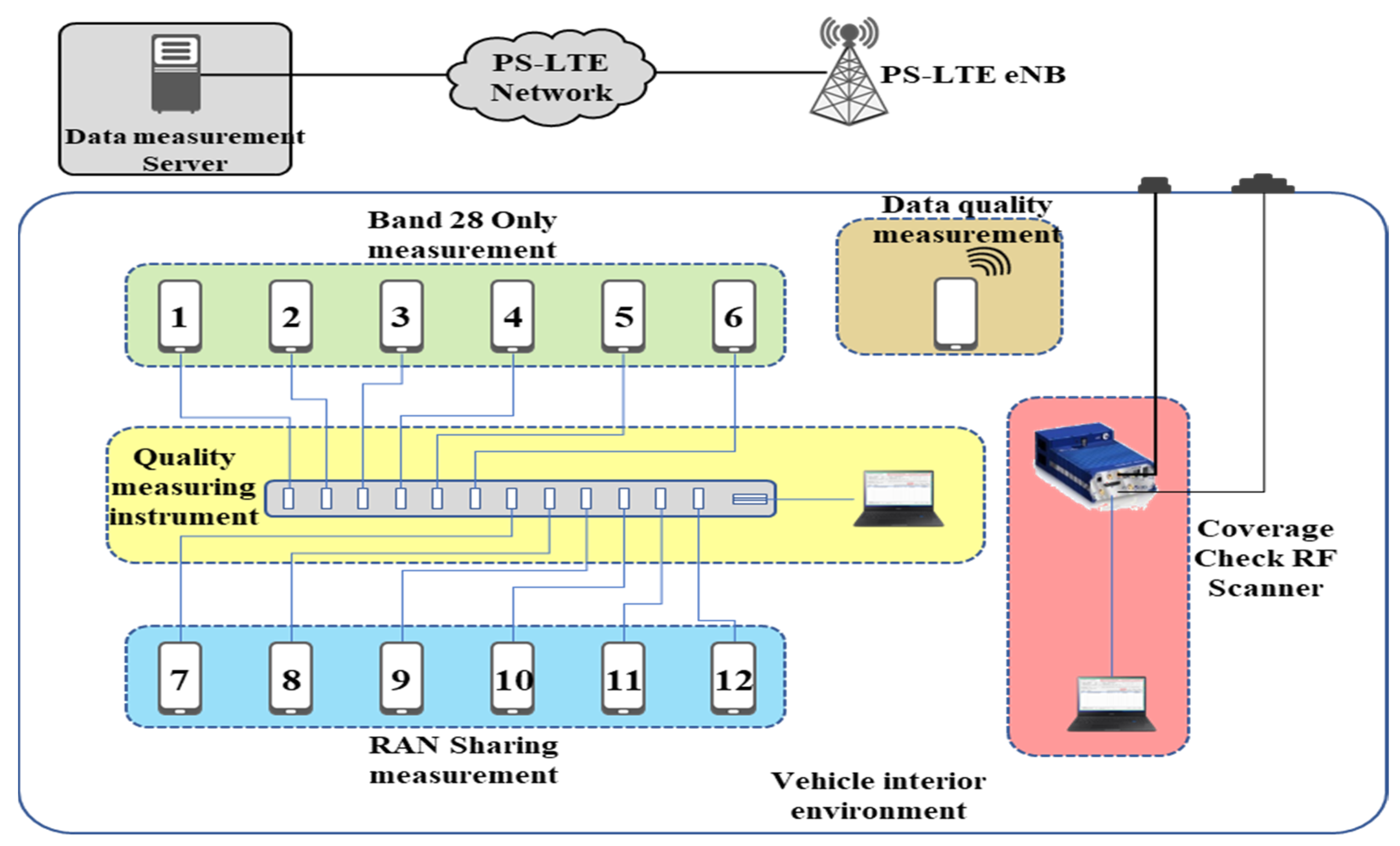




| Items | BHCA/User | VoLTE 1 Call Comparison | VoLTE 1 Call Conversion to BHCA | |
|---|---|---|---|---|
| Registration | Initial registration (MCPTT basis) | 0.1 BHRA | ||
| Refresh registration (MCPTT basis) | 1 BHRA | |||
| Deregistration (MCPTT basis) | 0.1 BHRA | |||
| Service BHCA | SMS BHCA | 1 BHCA | 30% | 0.3 BHCA |
| MCPTT BHCA | 1.76 BHCA | 100% | 1.76 BHCA | |
| Regi BHRA per subscriber | 1.2 BHRA | |||
| Service BHCA per subscriber | 2.06 BHCA | |||
| Regi BHRA based on 400,000 subscribers | 480,000 BHRA | |||
| Service BHCA based on 400,000 subscribers | 824,000 BHCA | |||
| Items | Type | Number of Transactions | BHCA/User | Transactions per Hour |
|---|---|---|---|---|
| Attach | INIT | 10 | 0.4 | 4 |
| Detach | Detach UE | 3 | 0.09 | 0.27 |
| Detach NW | 1 | 0.04 | 0.04 | |
| Preservation | eNB init S1 REL | 2.5 | 38.33 | 95.83 |
| Service request | UE | 2.5 | 18.88 | 47.2 |
| NW | 3 | 37.76 | 113.28 | |
| Session management | PDN connection | 4 | 0.63 | 2.52 |
| PDN disconnection | 3 | 0 | 0 | |
| Bearer activation | 2.5 | 2.08 | 5.2 | |
| Bearer deactivation | 2.5 | 2.08 | 5.2 | |
| Tracking area update | No change | 2.5 | 0 | 0 |
| S-GW relocation | 4.5 | 0 | 0 | |
| MME/S-GW relocation | 9 | 0.1 | 0.9 | |
| Periodic TAU | 3.5 | 0.12 | 0.42 | |
| Handover | X2 | 3 | 5.06 | 15.18 |
| S1 | 11.5 | 0.1 | 1.15 | |
| S1AP paging | PAGING | 0.2 | 536.84 | 107.368 |
| TPH per subscriber | 398.553 TPH | |||
| TPS per subscriber | 0.1107 TPS | |||
| TPS based on 400,000 subscribers | 44,283.67 TPS | |||
| Items | Number of Transactions | BHCA/ Subscriber | Transactions per Hour | |
|---|---|---|---|---|
| Attach/Detach | 7 | 0.53 | 3.71 | |
| TAU | w/SGW relocation | 0 | 0 | 0 |
| w/MME and SGW relocation | 1 | 0.1 | 0.1 | |
| No change | 0 | 0 | 0 | |
| Periodic TAU | 1 | 0.12 | 0.12 | |
| Bearer activation | 1 | 2.08 | 2.08 | |
| Bearer deactivation | 1 | 2.08 | 2.08 | |
| X2 handover | w/o SGW relocation | 1 | 5.06 | 5.06 |
| w/SGW relocation | 1 | 0 | 0 | |
| S1 handover | w/MME relocation | 1 | 0.1 | 0.1 |
| UE init request (idle → active) | 1 | 18.88 | 18.88 | |
| UE init request (idle ← active) | 2 | 37.76 | 75.52 | |
| S1 release (active → idle) | 1 | 38.33 | 38.33 | |
| PDN connection/disconnection | 5 | 0.63 | 3.15 | |
| TPH per subscriber | 149.13 | |||
| TPS per subscriber | 0.0414 | |||
| TPS based on 400,000 subscribers | 16,570 | |||
| Throughput (Kbps) per subscriber | 20.85 | |||
| Throughput (Gbps) based on 400,000 subscribers | 8.34 | |||
| Manufacturer | Service | KPI 1 (ms) | KPI 2 (ms) | KPI 3 (ms) |
|---|---|---|---|---|
| A | Group voice | 23 | 271 | 170 |
| B | 29 | 331 | 247 | |
| C | 27 | 331 | 263 | |
| D | 42 | 402 | 248 |
| Item | Private Currency (s) | Group Calls (s) | ||||
|---|---|---|---|---|---|---|
| Voice | Text | Video | Voice | Text | Video | |
| Idle time | 10 | 5 | 10 | 10 | 10 | 10 |
| Setup time | 20 | 10 | 20 | 30 | 30 | 30 |
| Traffic time | 65 | 10 | 65 | 30 | 10 | 30 |
| Total | 95 | 25 | 95 | 70 | 50 | 70 |
| Indicators | Description |
|---|---|
| Connection success rate | The rate at which the connection is completed within a certain base time among the calls of a connection attempt. |
| Dropped call rate | The rate at which the call is cut off within a certain call time among the calls of a successful connection. |
| Voice quality | Measurement on a five-point scale for quality deterioration between original and received voices. (ITU-T P.862 PESQ or P.863 POLQA standard algorithm applied). |
| Call success rate | Call rate of successful calls above MOS threshold among call attempts. |
| Category | Test Content | Test Criteria |
|---|---|---|
| Convenience | The ability to move the mobile base station quickly and provide immediate service in the field |
|
| Coverage | Coverage by wireless environment | Effective coverage measurement (downtown area, empty site, and mountainous areas) |
| Interoperability | Handover testing (RAN sharing, etc.)
|
|
| Call quality |
| Call service based on quality verification indicators |
Publisher’s Note: MDPI stays neutral with regard to jurisdictional claims in published maps and institutional affiliations. |
© 2021 by the authors. Licensee MDPI, Basel, Switzerland. This article is an open access article distributed under the terms and conditions of the Creative Commons Attribution (CC BY) license (https://creativecommons.org/licenses/by/4.0/).
Share and Cite
Lee, J.-J.; Park, P.-K.; Chung, B.-C.; Kim, S.-W.; Nam, K.-D.; Rhee, W.-S. Call Model and Test-Verification Methods for PS-LTE Core Equipment. Electronics 2021, 10, 2513. https://doi.org/10.3390/electronics10202513
Lee J-J, Park P-K, Chung B-C, Kim S-W, Nam K-D, Rhee W-S. Call Model and Test-Verification Methods for PS-LTE Core Equipment. Electronics. 2021; 10(20):2513. https://doi.org/10.3390/electronics10202513
Chicago/Turabian StyleLee, Jae-Jeong, Pyung-Koo Park, Byung-Chang Chung, Sang-Wan Kim, Ki-Dong Nam, and Woo-Seop Rhee. 2021. "Call Model and Test-Verification Methods for PS-LTE Core Equipment" Electronics 10, no. 20: 2513. https://doi.org/10.3390/electronics10202513
APA StyleLee, J.-J., Park, P.-K., Chung, B.-C., Kim, S.-W., Nam, K.-D., & Rhee, W.-S. (2021). Call Model and Test-Verification Methods for PS-LTE Core Equipment. Electronics, 10(20), 2513. https://doi.org/10.3390/electronics10202513







